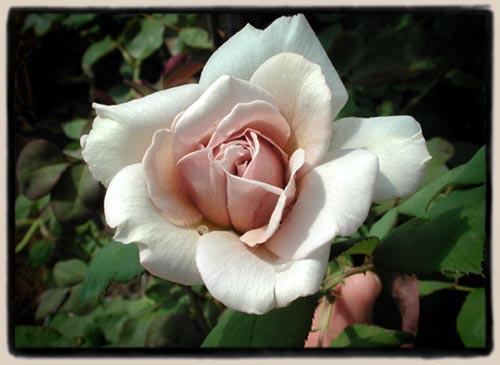 |
|
Albas |
Welcome to the June 2003 edition of my web site! The roses I write about are the Old Garden Roses and select shrub and miniature roses of the 20th century. For tips on rose culture, pruning, propagation and history, see the "Site Resources Guide" box in the navigation panel at left. To return to this page, click on the "thorn icon" in the margin at left. Articles from the previous months are archived and can be viewed by clicking on the listings in the left margin. Oh, and please don't write to me for a catalog or pricelist.....this is an information site only, not a commercial nursery. If you wish to buy roses, see my sponsor, The Uncommon Rose. A
Subtle Beauty—Brown and Other Odd-Colored Roses
Above: 'Grey Pearl' Any discussion of rose colors must begin with a major caveat almost always ignored by glossy, tempting rose photographs in catalogues: more than any other flowering plant, rose color is extremely variable. And more than any other color of rose, brown roses are subject to that variability. These changes can be governed by soil type, overall climate, differences in local weather, changes of season, and even variations in the amount or strength of sunlight a rose receives. Brown roses are greatly influenced by all of the above factors. For that reason, my comments must be taken in the context of my local climate, the coastal area of Southern California. This is an area characterized by brief, mild (no recorded frost for over 20 years), somewhat rainy winters; warm, sunny weather in early spring followed by a cool, overcast period during the months of May and June; sunny summers with temperatures that hardly go above the low 80s in daytime or below the 60s at night; long, mild autumns that mirror the overcast late springs—although less reliably, and almost no rainfall between mid-March and mid-October. The water is quite alkaline and the native soil is clay, requiring constant efforts to lighten and acidify the growing environment.
In such a circumstance, each season produces a different hue in most of my roses, but especially the browns. I mention this so that readers in different areas will be aware of the tremendous range of and variations in shadings, and not feel a rose has been mislabeled or inaccurately described simply because it has a smoky maroon tone when they had expected burnt orange. For example, I was shocked and infuriated when 'Café' (see below) produced an autumn flush—followed by an identical spring flush—of egg yolk-yellow blooms instead of its trademark coffee with cream color. Fortunately, as soon as the weather warmed up, the blooms reverted to "normal." Except for giving a bit of extra iron (which tends to intensify rose colors—especially in alkaline soils), or providing light shade, particularly from the hot afternoon sun in summer, there’s not much you can do about temperature-induced color fluctuations. Let’s talk color: The ARS has painted hybridizers of brown roses into a chromatic corner by providing only one color category—russet—for them to put an entire palette of color permutations into. Add to that the fact that we’ve come to call this group "brown roses" or, even more narrowly, "coffee roses," and you have a perfect recipe for misunderstanding. Although we use the term "brown," the reality of this category is that there are several sub-groupings in terms of color—all of them subtle, but few, if any, the average person would really call brown. Having grown about 98 percent of all the brown roses available in this country, I’ve concluded that they fall—not always neatly—into three general color categories: russet/red-browns that can range from oxblood to tobacco to copper; "warm" beige-tan/tawny golds that always carry a hint—sometimes well-hidden, sometimes not—of yellow; and "cool" beige-parchment tones that have a greyed or "ashen" shade due to an undertone—sometimes faint, sometimes obvious—of bluish pink or lavender.
At Right: 'Lavender Pinocchio' You wouldn’t think that the hybridizing of most brown roses was only made possible by the creation of the first "grey" rose, but that’s how it all came about. In 1945, the great Sam McGredy created 'Grey Pearl' (originally given the derisive name of "The Mouse" by its creator), a rose he disliked and dismissed, but which caught the attention of Gene Boerner of Jackson&Perkins. McGredy’s despised Hybrid Tea, however, (along with Boerner’s own 1948 creation, Lavender Pinocchio, itself the result of a cross between 'Grey Pear'l and 'Pinocchio' (a cool pink floribunda with touches of salmon-orange) became the spiritual, if not genetically literal, great granddaddy of all the brown and grey/lavender roses that were to come. The big name in brown roses is E. B. (Edward Burton) LeGrice. Although LeGrice wasn’t the very first to breed roses in these unusual shades—that distinction, as mentioned above, belongs to Sam McGredy and Gene Boerner who actually paved the way for LeGrice and others—LeGrice was the one who later took the genetic ball and ran with it. Click here for Part 2 of this article.
There
have been |
|


 At
Left: 'Latte', by the late Jerry Justice.
At
Left: 'Latte', by the late Jerry Justice.
